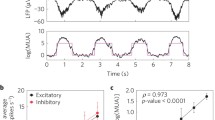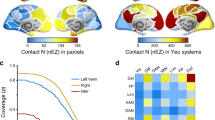Abstract
Periodic synchronization of activity among neuronal pools has been related to substantial neural processes and information throughput in the neocortical network. However, the mechanisms of generating such periodic synchronization among distributed pools of neurons remain unclear. We hypothesize that to a large extent there is interplay between the topology of the neocortical networks and their reverberating modes of activity. The firing synchronization is governed by a nonlocal mechanism, the network delay loops, such that distant neuronal pools without common drives can be synchronized. This theoretical interplay between network topology and the synchronized mode is verified using an iterative procedure of a single intracellularly recorded neuron in vivo, imitating the dynamics of the entire network. The input is injected to the neuron via the recording electrode as current and computed from the filtered, evoked spikes of its pre-synaptic sources, previously emulated by the same neuron. In this manner we approximate subthreshold synaptic inputs from afferent neuronal pools to the neuron. Embedding the activity of these recurrent motifs in the intact brain allows us to measure the effects of connection probability, synaptic strength, and ongoing activity on the neuronal synchrony. Our in vivo experiments indicate that an initial stimulus given to a single pool is dynamically evolving into the formations of zero-lag and cluster synchronization. By applying results from theoretical models and in vitro experiments to in vivo activity in the intact brain, we support the notion that this mechanism may account for the binding activity across distributed brain areas.







Similar content being viewed by others
References
Abeles M (1991) Corticonics: neural circuits of the cerebral cortex. Cambridge University Press, New York
Abeles M, Hayon G, Lehmann D (2004) Modeling compositionality by dynamic binding of synfire chains. J Comput Neurosci 17:179–201
Amit DJ (1995) The hebbian paradigm reintegrated: local reverberations as internal representations. Behav Brain Sci 18:617–626
Arieli A, Sterkin A, Grinvald A, Aertsen A (1996) Dynamics of ongoing activity: explanation of the large variability in evoked cortical responses. Science 273:1868–1871
Bienenstock E (1995) A model of neocortex. Netw Comput Neural Syst 6:179–224
Binder MD, Powers RK (2001) Relationship between simulated common synaptic input and discharge synchrony in cat spinal motoneurons. J Neurophysiol 86:2266–2275
Brama H, Peleg Y, Kinzel W, Kanter I (2013) Transient to zero-lag synchronization in excitable networks. Phys Rev E 87:032813
Buzsáki G (2010) Neural syntax: cell assemblies, synapsembles, and readers. Neuron 68:362–385
Buzsáki G, Draguhn A (2004) Neuronal oscillations in cortical networks. science 304:1926–1929
Cao J, Li L (2009) Cluster synchronization in an array of hybrid coupled neural networks with delay. Neural Netw 22:335–342
Câteau H, Fukai T (2001) Fokker-Planck approach to the pulse packet propagation in synfire chain. Neural Netw 14:675–685
Curtis CE, D’Esposito M (2003) Persistent activity in the prefrontal cortex during working memory. Trends Cognit Sci 7:415–423
Datta A, Stephens J (1990) Synchronization of motor unit activity during voluntary contraction in man. Journal Physiol 422:397–419
Destexhe A, Rudolph M, Paré D (2003) The high-conductance state of neocortical neurons in vivo. Nat Rev Neurosci 4:739–751
Diesmann M, Gewaltig MO, Aertsen A (1999) Stable propagation of synchronous spiking in cortical neural networks. Nature 402:529–533
Engel AK, Fries P, Singer W (2001) Dynamic predictions: oscillations and synchrony in top–down processing. Nat Rev Neurosci 2:704–716
Gerstner W, Kistler WM (2002) Spiking neuron models: Single neurons, populations, plasticity. Cambridge university press, New York
Gewaltig MO, Diesmann M, Aertsen A (1995) Propagation of synfire activity in cortical networks: a statistical approach. In:Kappen B, Gielen S (eds) Neural networks: artificial intelligence and industrial applications, Springer, Berlin, pp 37–40
Gray CM, König P, Engel AK, Singer W (1989) Oscillatory responses in cat visual cortex exhibit inter-columnar synchronization which reflects global stimulus properties. Nature 338:334–337
Gütig R, Sompolinsky H (2006) The tempotron: a neuron that learns spike timing–based decisions. Nat Neurosci 9:420–428
Hebb DO (2002) The organization of behavior: a neuropsychological theory. Psychology Press, New York
Ikegaya Y, Aaron G, Cossart R, Aronov D, Lampl I, Ferster D, Yuste R (2004) Synfire chains and cortical songs: temporal modules of cortical activity. Science 304:559–564
Kanter I, Kopelowitz E, Vardi R, Zigzag M, Cohen D, Kinzel W (2011a) Nonlocal mechanism for synchronization of time delay networks. J Stat Phys 145:713–733
Kanter I, Kopelowitz E, Vardi R, Zigzag M, Kinzel W, Abeles M, Cohen D (2011b) Nonlocal mechanism for cluster synchronization in neural circuits. EPL Europhys Lett 93:66001
Kanter I, Zigzag M, Englert A, Geissler F, Kinzel W (2011c) Synchronization of unidirectional time delay chaotic networks and the greatest common divisor. EPL Europhys Lett 93:60003
Katz B, Miledi R (1965) The measurement of synaptic delay, and the time course of acetylcholine release at the neuromuscular junction. Proc Royal Soc Lond Ser B Biol Sci 161:483–495
Kirkwood PA, Sears TA (1978) The synaptic connexions to intercostal motoneurones as revealed by the average common excitation potential. Journal Physiol 275:103–134
Legendy C (1967) On the scheme by which the human brain stores information. Math Biosci 1:555–597
Litvak V, Sompolinsky H, Segev I, Abeles M (2003) On the transmission of rate code in long feedforward networks with excitatory–inhibitory balance. J Neurosci 23:3006–3015
Mainen ZF, Sejnowski TJ (1995) Reliability of spike timing in neocortical neurons. Science 268:1503–1506
Markram H, Tsodyks M (1996) Redistribution of synaptic efficacy between neocortical pyramidal neurons. Nature 382:807–810
Milo R, Shen-Orr S, Itzkovitz S, Kashtan N, Chklovskii D, Alon U (2002) Network motifs: simple building blocks of complex networks. Science 298:824–827
Nowotny T, Huerta R (2003) Explaining synchrony in feed-forward networks. Biol Cybern 89:237–241
Reyes AD (2003) Synchrony-dependent propagation of firing rate in iteratively constructed networks in vitro. Nat Neurosci 6:593–599
Salinas E, Sejnowski TJ (2001) Correlated neuronal activity and the flow of neural information. Nat Rev Neurosci 2:539–550
Schonewille M et al (2006) Purkinje cells in awake behaving animals operate at the upstate membrane potential. Nat Neurosci 9:459–461
Shadlen MN, Newsome WT (1998) The variable discharge of cortical neurons: implications for connectivity, computation, and information coding. J Neurosci 18:3870–3896
Singer W (1993) Synchronization of cortical activity and its putative role in information processing and learning. Annu Rev Physiol 55:349–374
Stern EA, Kincaid AE, Wilson CJ (1997) Spontaneous subthreshold membrane potential fluctuations and action potential variability of rat corticostriatal and striatal neurons in vivo. J Neurophysiol 77:1697–1715
Stern EA, Jaeger D, Wilson CJ (1998) Membrane potential synchrony of simultaneously recorded striatal spiny neurons in vivo. Nature 394:475–478
Vardi R, Wallach A, Kopelowitz E, Abeles M, Marom S, Kanter I (2012) Synthetic reverberating activity patterns embedded in networks of cortical neurons. EPL Europhys Lett 97:66002
Varela F, Lachaux JP, Rodriguez E, Martinerie J (2001) The brainweb: phase synchronization and large-scale integration. Nat Rev Neurosci 2:229–239
Wallace DJ, Kerr JN (2010) Chasing the cell assembly. Curr Opin Neurobiol 20:296–305
Wilson CJ, Kawaguchi Y (1996) The origins of two-state spontaneous membrane potential fluctuations of neostriatal spiny neurons. Journal Neurosci 16:2397–2410
Womelsdorf T, Schoffelen JM, Oostenveld R, Singer W, Desimone R, Engel AK, Fries P (2007) Modulation of neuronal interactions through neuronal synchronization. Science 316:1609–1612
Acknowledgments
The authors thank Noa Menkes-Caspi, Vered Kellner, Shlomit Beker, Igor Reidler and Hana Arnon for technical assistance. Funding for this study was provided by the Legacy Heritage Bio-Medical Program of the Israel Science Foundation (688/10).
Conflict of interest
The authors declare that we have no conflict of interest.
Author information
Authors and Affiliations
Corresponding authors
Additional information
H. Brama and S. Guberman have contributed equally to this work.
Electronic supplementary material
Below is the link to the electronic supplementary material.
Supplementary material 2 (MPG 32834 kb)
Rights and permissions
About this article
Cite this article
Brama, H., Guberman, S., Abeles, M. et al. Synchronization among neuronal pools without common inputs: in vivo study. Brain Struct Funct 220, 3721–3731 (2015). https://doi.org/10.1007/s00429-014-0886-6
Received:
Accepted:
Published:
Issue Date:
DOI: https://doi.org/10.1007/s00429-014-0886-6




